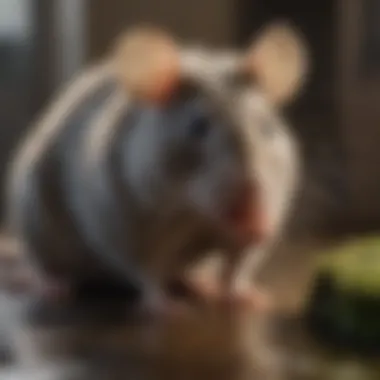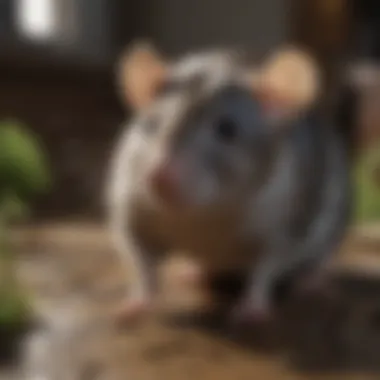Effective Strategies for Terminating Rats at Home


Intro
Rat infestations can be a significant concern for homeowners. Understanding how to effectively manage these pests is crucial. This article aims to provide practical strategies for terminating rats and preventing their return. Effective pest control is not just about eliminating a current problem. It also encompasses understanding the biology of rats and employing preventative measures to ensure a rat-free environment.
Understanding Pests
Definition of Pests
Pests are organisms that cause damage or nuisance to human populations, property, and health. Rats fall into this category due to their ability to reproduce rapidly and their tendency to invade homes in search of food, water, and shelter. They can transmit diseases and cause structural damage by gnawing on wires and insulation.
Importance of Pest Identification
Identification is the first step in effective pest management. Knowing the species of rat you are dealing with can help homeowners choose the best control methods. Common species in homes include the Norway rat and the roof rat. Each species may have different habits and preferred habitats, influencing how you approach the infestation.
Prevention Techniques
Home and Garden Preventative Measures
Preventing rats from entering your home requires a holistic approach. Some strategies include:
- Seal Entry Points: Inspect your home for cracks in walls, gaps around doors, and holes in foundations. Use materials like steel wool or caulk to seal these openings.
- Proper Food Storage: Store food in airtight containers. Clean up crumbs and spills immediately to eliminate potential food sources.
- Remove Clutter: Keep areas both inside and outside your home organized. Eliminate piles of leaves, wood, or clutter which can serve as nesting sites.
Seasonal Prevention Tips
Rats can enter homes more frequently during colder months. Consider these seasonal tips:
- Winter-Proofing: Ensure your heating vents and pipes are secure. Rats seek warmth in winter.
- Yard Maintenance: Trim bushes and branches that touch the house to create barriers for rats. Regularly mow the lawn and clean garden debris.
Eco-Friendly Pest Control Solutions
Overview of Sustainable Practices
Modern pest management emphasizes sustainability. Eco-friendly methods focus on reducing harm to the environment while effectively managing pests. This includes using traps instead of poisons, and encouraging natural predators like owls.
Natural Remedies and Their Effectiveness
Some homeowners may prefer to use natural alternatives for rat control. Common methods include:
- Essential Oils: Peppermint oil is known to repel rats. Soak cotton balls in it and place them in areas of rat activity.
- Chemical-Free Traps: Snap traps and live traps can be effective. Ensure they are used safely, following guidelines to prevent harm to pets and children.
"Prevention and responsible pest management are key to ensure a rat-free home."
It is important to blend practical advice with ecological consciousness when managing pests. By adopting a comprehensive approach to pest control, homeowners can create an environment that is less inviting to rats, safeguarding their homes and families.
Understanding Rat Behavior
Understanding rat behavior is crucial for effective pest management. This knowledge lays the groundwork for identifying when and where to target rat populations in and around the home. Knowing their behavioral patterns allows homeowners to anticipate rat movements, enhancing the effectiveness of trapping and baiting strategies. Proper understanding also plays a role in reducing fear and anxiety related to rat infestations.
Biology of Common Rat Species
Rats belong to the family Muridae and are characterized by their long tails and sharp incisors. The two most common rat species found in homes are the Norway rat and the roof rat. Norway rats are larger, with a robust body and a blunt snout. They often thrive in basements, sewers, and ground floors. On the other hand, roof rats have a slender build and prefer to nest in upper areas of buildings such as attics. Their adaptability allows them to survive in various environments, from urban to rural settings. Understanding the characteristics of these species helps homeowners tailor their strategies accordingly.
Habitat Preferences and Nesting
Rats are exceptionally skilled at finding habitats that offer food, water, and shelter. Norway rats tend to favor burrows but will nest indoors in warm, hidden areas like behind appliances or in cluttered spaces. Roof rats prefer higher elevations, utilizing trees, vines, and buildings for nesting. By knowing their nesting preferences, homeowners can inspect their properties for potential nesting sites and take action to eliminate these areas.
- Indoor nesting sites: behind walls, in attics, or any cluttered area.
- Outdoor nesting sites: under debris, in bushes, or around the perimeter of the home.
Effective management requires consistent inspections of these areas.
Feeding and Foraging Habits
Rats are opportunistic feeders and can consume a wide variety of foods. This behavior often leads them to raid garbage cans, pet food containers, and pantries. Their foraging habits are typically nocturnal, making them most active during the night.
Common food sources that attract rats include:
- Grains: Found in birdseed, pet food, and human food storage.
- Fruits and vegetables: Leftovers in gardens or improperly stored food.
- Animal products: Meat scraps and cheese.


By recognizing these feeding habits, homeowners can take preventative measures such as securing trash, sealing food containers, and maintaining cleanliness to deter rats from frequenting their homes.
"A clean environment is a key deterrent in managing rat populations effectively."
Overall, understanding rat behavior forms the foundation for effective strategies in terminating their presence at home. By recognizing their biology, habitat preferences, and feeding habits, homeowners can make informed decisions to handle the situation. This information is not only beneficial for immediate action but is also vital for long-term prevention.
Identifying Rat Infestations
Identifying rat infestations is a crucial step in addressing the presence of these pests in your home. Early detection can significantly reduce damage and health risks associated with rodents. Understanding the signs of infestation, common entry points, and differentiating between various types of rodents helps homeowners take swift action. This knowledge not only safeguards your property but also contributes to a more effective pest management strategy.
Signs of Rat Presence
Rats are often elusive, making it important to know the signs of their presence. Common indicators include:
- Droppings: Rat droppings are typically dark and cylindrical, measuring about a half inch long. They are often found in areas where rats are active, such as beneath sinks or along walls.
- Gnaw Marks: Rats need to gnaw in order to keep their teeth from growing too long. Look for bite marks on food packaging, wires, or furniture.
- Nesting Materials: Rats often use shredded paper, fabric, or insulation to create nests. Finding these materials tucked away in sheltered places can indicate a nesting site.
- Tracks or Smudge Marks: Rats tend to leave faint tracks and greasy smudge marks along walls from their fur. A flashlight can help reveal these signs in dark areas.
- Nocturnal Activity Sounds: Noises such as scratching or squeaking at night can be a sign of rat activity. Pay attention to these sounds if they occur frequently.
Common Entry Points in Homes
Rats can enter homes through various openings, often surprisingly small. Being aware of these entry points is essential for effective pest control. Common areas of entry include:
- Gaps Around Doors and Windows: Small cracks or gaps can allow rats to squeeze through. Ensure that doors and windows are well-sealed.
- Vents and Ducts: Rats can access homes through ventilation systems. Mesh screens can help keep them out.
- Utility Lines: Gaps around pipes and electrical lines can serve as entry points. Seal these areas to prevent entry.
- Cracks in the Foundation: Inspect the foundation and walls of your home for cracks. It's vital to patch any potential holes that could allow rodent access.
- Attics and Basements: Rats often find entry into attics and basements through holes in the roof or foundation. Regular inspections can help identify such vulnerabilities.
Differentiating Between Rodents
Identifying the specific type of rodent can affect your control measures. While most homeowners might encounter brown or black rats, distinguishing them can help tailor your pest management approach.
- Norway Rat: Recognized by its robust body and blunt muzzle. It prefers living under basements and in piles of debris.
- Roof Rat: A sleeker rodent, often found in attics and trees. It has a pointed nose and prefers high places for nesting.
- House Mouse: Though smaller, house mice can also carry disease and infest homes. Their droppings are smaller than those of rats.
Understanding the specific rodent type can lead to more effective methods of elimination and prevention.
Being aware of these characteristics will assist homeowners in choosing the right strategies for pest control and ensuring a healthier living space.
Identifying rat infestations early can greatly enhance the effectiveness of any subsequent actions taken to eliminate these pests from your home.
Methods for Rat Termination
Understanding how to effectively terminate rats in your home is crucial for a number of reasons. Rat infestations can cause significant damage to property and can also pose health risks to humans and pets. By employing effective termination methods, homeowners can minimize these risks and restore their living spaces to a safe and healthy condition. This section discusses three primary methods for rat termination: trapping, poison bait applications, and natural solutions. Each method carries its own considerations and benefits, offering a comprehensive approach to addressing rat infestations.
Trapping Techniques
Trapping is a popular method for rat termination. It offers immediate results and allows homeowners to control the infestation without chemicals. There are different types of traps available, each suited for various needs.
Types of Traps
Many traps exist, with the most common being snap traps, glue traps, and electronic traps. Snap traps are effective because they kill rats instantly, minimizing suffering and the likelihood of escape. Glue traps, on the other hand, capture rats but do not kill them immediately, which can lead to prolonged suffering. Electronic traps deliver a quick, lethal shock, and can handle multiple captures without needing frequent checks. Each type has distinctive features that can influence effectiveness.
Advantages of using traps include their non-toxic nature and the ability to use them in homes with children or pets. However, trap placement is critical for success.
Trap Placement Strategies
Where traps are placed greatly affects their efficiency. Ideally, traps should be positioned along rat pathways, near nests, and in areas with droppings. Strategic placement is crucial for maximizing capture rates. Using several traps at once increases the chances of catching multiple rodents.
A unique feature of this strategy is the potential for placing traps in concealed locations, which can prevent pets or children from accessing them. However, it requires regular checks to ensure traps are functioning and to dispose of captured rats promptly.
Handling Captured Rats
After capturing rats, proper handling is important. Rats can carry diseases, so using gloves is recommended. Disposing of dead rats should be done in accordance with local regulations. Disposal might include placing them in a sealed bag and throwing them in the trash. This handling helps reduce the risk of contaminating your home environment.
Unique to this part of rat termination is also the emotional aspect. Some people may feel distressed upon handling trapped animals. It’s important to maintain a practical approach, emphasizing safety and hygiene.
Poison Bait Applications
The use of poison baits can be effective for rat termination when used correctly. Poison baits can reach areas trapping may not, effectively controlling larger infestations.
Safety Considerations
Safety is paramount when using poison baits. Rodenticides can be dangerous to pets and non-target wildlife. Before use, ensure that the bait is placed securely, preferably in tamper-resistant bait stations. This containment minimizes risks of accidental ingestion.


The unique feature here is the availability of various formulations. Some baits are less toxic and are designed specifically for household use, which is beneficial. However, caution is always necessary to prevent harm to unintended targets.
Types of Rodenticides
There are different types of rodenticides available. Anticoagulants are the most common; they prevent blood clotting, leading to death over a few days. Other types include neurotoxins that act more quickly but may have more severe consequences if misused. Understanding these variations is essential in choosing the right product.
Rodenticides can be effective but come with ethical concerns regarding their impact on predator species in the environment. This aspect should be considered carefully.
Proper Usage Guidelines
Using poison correctly is vital. Always follow product instructions carefully. Bait should be placed in areas with high rat activity but away from children and pets. It’s important to monitor the stations regularly after placing baits to ensure they are effective and to replace them as necessary.
The special intent of using clear guidelines is to protect the family and environment while addressing the infestation. Though poison is effective, it requires diligence in application and monitoring.
Natural and Eco-Friendly Solutions
For homeowners looking for alternative methods, natural and eco-friendly solutions offer alternatives without chemicals.
Homemade Repellents
Homemade repellents can deter rats without causing harm. Ingredients such as peppermint oil, cayenne pepper, and vinegar can create mixtures that are unappealing to rats. Spraying these areas around entry points may help in discouraging them from returning.
The unique characteristic of homemade repellents is their safety. They pose no health risks to pets or children. However, their effectiveness can vary, and continual application may be necessary.
Encouraging Natural Predators
Encouraging natural predators like cats or owls can also keep rat populations in check. This method creates a balanced ecosystem, making homes less inviting to rats. Placing birdhouses or nesting boxes can invite owls, while simply having a cat can provide regular patrols of the area.
This approach has its benefits, such as reducing reliance on chemical solutions and providing a natural method of control. However, it may take time for natural predators to establish a presence, and it is a less immediate solution compared to traps or baits.
Remember, combining different methods is often the best approach to effectively handle rat infestations, considering both safety and ecological impact.
Preventing Future Infestations
Preventing future infestations is a critical aspect of managing rat problems in the home. After addressing existing infestations, it is essential to implement strategies that minimize the risk of rats returning. Effective prevention not only saves homeowners from repeated stress and financial burden, but it also contributes to a healthier living environment. Rat infestations can lead to damages, unsanitary conditions, and potential health risks. Therefore, understanding and applying preventive measures is vital for long-term home protection.
Sanitation Practices
Sanitation practices play a central role in deterrence. Rats are opportunistic feeders. They thrive in environments with ample food sources. Keeping your home clean significantly reduces the chances of attracting these pests. Here are some key practices:
- Store Food Properly: Always keep food in sealed containers. This includes pet food, as well.
- Clean Up Food Debris: Regularly sweep floors and clean countertops. Make sure there are no crumbs lingering around.
- Take Out Trash Regularly: Dispose of garbage in sealed bins and take it out frequently. An overflowing bin attracts rats.
- Eliminate Water Sources: Fix leaks and ensure there is no standing water. Rats need water to survive, so removing this source is crucial.
By following these sanitation measures, the likelihood of attracting rats can be drastically reduced.
Structural Repairs and Modifications
Structural repairs and modifications also form a key pillar in preventing rat infestations. This means addressing vulnerabilities in the home that rats might exploit. Here are some strategies:
- Seal Entry Points: Inspect the house for holes or cracks, especially around doors, windows, and the foundation. Sealing these gaps can block entry.
- Install Screens: Use wire mesh or screens on vents and chimneys to prevent access. Ensure these barriers are tight and without gaps.
- Landscape Changes: Trim trees and shrubs. Rats can use these as highways to reach your home. Keeping a safe distance can help.
- Proper Drainage: Ensure the drainage system is working correctly. Blocked drains can offer access points.
Implementing these repairs ensures a robust defense against potential invaders.
Monitoring and Regular Inspections
Monitoring and regular inspections are indispensable components of an effective prevention strategy. Staying proactive allows homeowners to catch issues before they escalate. Here are some steps:
- Schedule Routine Inspections: Conduct comprehensive checks around the home regularly. Look for droppings or signs of gnawing.
- Use Cameras or Traps as Monitors: Setting up cameras can provide insights into rodent activity, allowing you to address issues promptly.
- Involve Neighbors: Share information with nearby homeowners. A community-wide approach is beneficial in managing rat populations.
- Educate All Household Members: Ensure everyone understands the signs of rat activity and how they can contribute to prevention efforts.
By committing to these monitoring practices, you empower yourself to maintain a rat-free home.
Ethical Considerations in Pest Control
The approach to pest control raises significant ethical concerns that extend beyond mere effectiveness. In dealing with rat infestations, it becomes crucial to consider humane practices, environmental impacts, and the balance between safety and efficacy. This section will articulate these pertinent aspects to foster a responsible attitude towards pest management.
Humane Treatment of Rodents
Humane pest control practices prioritize the well-being of animals, even when they interfere with human environments. Rats, while capable of causing damage and posing health risks, are sentient creatures. They exhibit complex behaviors, forming social bonds and seeking family groups.


When addressing a rat infestation, homeowners should consider non-lethal options first. Live traps can capture rats without causing harm, which allows for relocation. However, relocation must be conducted with care. It is critical to choose a suitable environment where the displaced rats can thrive, such as natural habitats away from human dwellings.
In addition, education about the life cycle and social structure of rats can foster empathy. Understanding their behavior encourages more thoughtful strategies, reducing unnecessary suffering and promoting ethical treatment.
Environmental Impact of Rodenticides
Rodenticides are commonly used in managing rat populations but pose various environmental hazards. Many of these substances are not selective and can affect non-target species, including pets and wildlife. Moreover, the ingestion of poisoned rats can harm animals that prey on them, leading to a cascade of ecological consequences.
Some specific concerns include:
- Bioaccumulation: Certain rodenticides can accumulate in the food chain, posing long-term risks to ecosystems.
- Loss of biodiversity: The depletion of native predator populations affected by poisons may have drastic effects on local fauna.
- Soil and water contamination: Residues can leach into soil and water systems, impacting plant and animal life.
Therefore, while rodenticides might offer quick results, the broader implications underscore the necessity of careful consideration when choosing pest control methods.
Balancing Safety and Effectiveness
Effective pest control should not compromise safety. This is a critical consideration for households with children and pets. An approach that combines safety and effectiveness offers a dual solution that satisfies both ethical and practical needs.
Strategies to balance these concerns include:
- Using traps instead of poisons: This ensures immediate safety for non-target species, while still allowing for effective management of the pest population.
- Selecting safer rodenticides: If poisons are unavoidable, homeowners should opt for products that have lower risks to non-target organisms. Often, newer formulations are designed with these considerations in mind.
- Regular monitoring: Continually assessing traps or bait stations minimizes unintended consequences, ensuring that non-target species are not harmed.
"Adopting a holistic view in pest control can ensure that we maintain the safety of our homes while acting ethically towards our environment."
These balanced approaches enable responsible pest management that serves both human interests and ecological integrity. Often, community input or collaborating with local pest control experts can yield effective and ethically grounded strategies.
Professional Help for Severe Infestations
When dealing with significant rat infestations, the need for professional help cannot be overlooked. Homeowners often underestimate the extent of damage and health risks that these pests pose. Rats carry various diseases and can contaminate food supplies, leading to serious health concerns. They are also known to cause structural damage through their incessant gnawing. While some infestations can be managed with traps and poisons, others may require the expertise of trained pest control professionals.
"Engaging a pest control expert can often save you time, money, and stress in managing a rat problem effectively."
It is crucial to recognize when regular methods become inadequate. In many cases, rats reproduce rapidly. A few individuals can quickly turn into a heavy infestation. Professionals have the tools and knowledge to assess the situation accurately. They can identify nesting sites and understand the behavior of the rat population involved.
When to Call an Exterminator
Determining the right moment to call an exterminator often hinges on several factors. If you notice signs such as active nests, droppings, or damage to the property, it might be time to seek professional assistance. Unusual noises in walls or ceilings, especially at night, can indicate a larger problem.
Consider enlisting the help of professionals if:
- The infestation appears extensive.
- DIY methods have failed to yield results.
- You are uneasy about handling traps or poisons.
- There are children or pets in the home that need protection from exposure to harmful substances.
Calling an exterminator sooner rather than later can prevent escalating issues and reduce potential health hazards. Effective extermination of rats often requires strategic planning and follow-up treatments that only professionals can provide.
Choosing a Pest Control Service
Selecting the right pest control company is essential for successful rat termination. Not all services are the same, and varying levels of expertise can affect the outcome. Begin by researching local pest control services. Check for licenses and certifications, which ensures compliance with regional regulations. Reviews and testimonials can provide insights into their effectiveness and customer satisfaction.
Focus on finding a service that:
- Offers integrated pest management strategies tailored to your home.
- Utilizes humane practices when possible.
- Provides a detailed plan of action, including preventive measures to avoid future infestations.
- Guarantees their work and offers follow-up inspections.
Be prepared to ask questions regarding their methods and products. Understanding their approach will help you feel secure in your choice. Remember, the goal is not just to eliminate rats but also to implement sustainable practices to prevent their return.
By considering these elements, homeowners can make informed decisions that minimize risks while effectively addressing rat infestations.
Further Reading
Engaging in further reading expands one's knowledge about rodent behavior, biology, and control methods. Resources like websites and articles dedicated to pest control can enhance your ability to identify potential problems before they escalate. Notable texts often include guides on safe trapping, environmental impact, and the biology of rats.
- Understanding the ecological role of rats can help frame pest control from a broader perspective.
- Researching various methods of pest management provides insights into which strategies align with your values and environmental considerations.
- Finding case studies on successful pest management can inspire confidence and optimism in your approach.
Websites such as Wikipedia and Britannica serve as excellent starting points for your research on rodents and pest management.
Local Pest Control Associations
Joining local pest control associations offers homeowners a direct line to assistance from experienced professionals. These organizations often provide valuable resources such as informational workshops, newsletters, and direct consultations with pest control experts. The benefits of connecting with these groups are manifold:
- You can gain access to local knowledge specific to your area’s rodent problems.
- Many associations facilitate networking with other homeowners and pest control professionals, which can provide support and share experiences.
- They often champion best practices, offering educational materials and updates regarding regulations that affect pest management.
In addition, national organizations and forums such as Reddit and even social platforms like Facebook foster discussions where members can share insights and solutions.
Engaging with your community through local pest associations not only enhances your pest management efforts but also contributes to a stronger support network.



